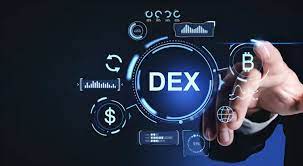In the world of decentralized finance (DeFi), uniswap platform stands as one of the most revolutionary platforms, reshaping how we trade cryptocurrencies. Its innovative approach to decentralized exchange (DEX) has disrupted the traditional finance system, providing users with a peer-to-peer method of trading tokens without the need for intermediaries. But what makes Uniswap so unique? Let’s dive into its workings, impact on the crypto landscape, and why it continues to lead the charge in DeFi.
What is Uniswap?
Uniswap is a decentralized exchange protocol built on the Ethereum blockchain that allows users to trade ERC-20 tokens directly with one another. Unlike centralized exchanges like Binance or Coinbase, which rely on an order book and match buyers with sellers, Uniswap uses an automated market maker (AMM) model. This eliminates the need for a central authority or intermediary, empowering users to retain full control over their assets.
The core of Uniswap’s innovation is its smart contract-driven liquidity pools. These pools enable users to trade assets without needing to find a counterparty directly. Instead, trades are executed through a set of pre-existing liquidity that is provided by other users, known as liquidity providers (LPs).
How Does Uniswap Work?
Uniswap’s mechanism relies heavily on its AMM, which uses a mathematical formula to determine the price of a token pair. The formula used by Uniswap is called the “constant product formula,” represented as: x×y=kx \times y = k
Where:
- x is the amount of one token in the pool.
- y is the amount of the other token in the pool.
- k is a constant that must always remain the same.
The idea is simple: when a user wants to swap tokens, they do so by interacting with the liquidity pool. As tokens are added or removed from the pool, the ratio between the two assets changes, which in turn adjusts the price. Since the formula keeps the product constant, prices automatically adjust based on supply and demand.
To incentivize users to provide liquidity, Uniswap rewards liquidity providers with a share of the trading fees. For example, whenever a trade occurs on the platform, a small fee (usually 0.3%) is charged. This fee is then distributed to liquidity providers based on their contribution to the pool.
The Role of Liquidity Providers
Liquidity providers (LPs) are the backbone of Uniswap’s ecosystem. They contribute an equal value of two tokens to a liquidity pool in exchange for a proportional share of the fees generated from trades. LPs can withdraw their liquidity at any time, along with the fees earned.
However, LPs face the risk of impermanent loss, a phenomenon that occurs when the relative price of the tokens in the liquidity pool changes. If the price of one token increases significantly compared to the other, LPs may lose out on potential gains from holding the tokens separately. Despite this risk, the rewards from transaction fees often outweigh the potential loss for many LPs, especially during periods of high trading volume.
Uniswap V3: A New Era
Uniswap V3, released in May 2021, introduced several significant upgrades over its predecessor. One of the most notable improvements is concentrated liquidity, which allows LPs to allocate their liquidity within specific price ranges rather than providing liquidity across the entire price curve. This gives LPs greater control over their capital efficiency, as they can now focus their liquidity on price ranges where most trades occur.
Another key feature of V3 is multiple fee tiers, which enable LPs to choose between different levels of fees based on the risk and volatility of the token pair they are providing liquidity for. This flexibility allows for better optimization of returns, catering to a wider range of liquidity providers with varying risk appetites.
Uniswap V3 also introduced non-fungible liquidity positions, meaning that each liquidity position is represented as a unique NFT (non-fungible token) that tracks the liquidity and fee earnings for that particular position. This allows LPs to trade, sell, or stake their positions, making liquidity provision more dynamic and customizable.
The Uniswap Governance Token (UNI)
In September 2020, Uniswap launched its governance token, UNI, allowing the community to participate in the decision-making process for the future of the protocol. UNI holders can vote on proposals related to protocol upgrades, fee changes, and the allocation of funds within the Uniswap treasury. This decentralized governance structure aligns with the broader ethos of DeFi, where control is distributed among the users rather than a centralized authority.
The launch of UNI also marked a major shift in how Uniswap distributes its tokens. Initially, the project was funded through venture capital, but the introduction of UNI provided an opportunity for users to have a stake in the platform’s success. The token distribution model was designed to reward users who contributed to the platform’s growth, with a portion of tokens allocated to liquidity providers, team members, and the community.
Uniswap’s Impact on the DeFi Ecosystem
Uniswap’s influence on the DeFi space cannot be overstated. It played a pivotal role in the rise of decentralized exchanges, opening the door for numerous other DEX platforms to emerge. By enabling anyone to trade tokens without a centralized authority, Uniswap has democratized access to financial markets, giving rise to new financial instruments, including decentralized lending, yield farming, and synthetic assets.
The success of Uniswap also spurred the development of Layer 2 solutions, like Optimism and Arbitrum, which offer faster and cheaper transactions by processing them off the Ethereum mainnet. This has addressed one of the primary criticisms of Ethereum-based DEXs—high gas fees—making Uniswap even more accessible to users worldwide.
Uniswap has become a cornerstone of the DeFi movement, setting the stage for the next phase of innovation in the financial space. As it continues to evolve, it will likely remain at the forefront of decentralized trading and liquidity provision.
Conclusion
Uniswap has redefined how users interact with financial markets by enabling decentralized, trustless trading through the use of automated market makers. Its innovative approach has not only reshaped the way we trade cryptocurrencies but has also laid the foundation for the growth of DeFi as a whole. With the launch of Uniswap V3 and the ongoing development of Layer 2 solutions, Uniswap is poised to continue its leadership role in the DeFi space, empowering users with more control over their financial assets and ushering in a new era of financial freedom.
As decentralized finance continues to grow, Uniswap’s contributions will undoubtedly play a central role in shaping the future of finance as we know it.

